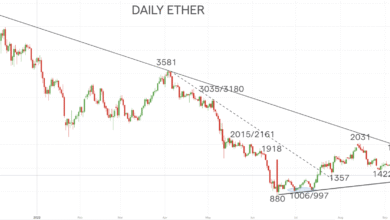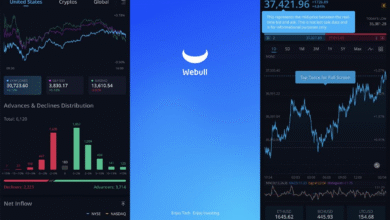Bitcoin Price Analysis: Market Volatility and Tariffs Impact
Bitcoin price analysis has become increasingly vital for investors navigating the turbulent waters of the crypto market. Following a dramatic rally that saw BTC soar above $123,000, recent declines highlight the inherent crypto market volatility that traders must contend with. Elements such as US tariffs and the geopolitical risks tied to international relations are influencing current BTC price trends, prompting investors to prepare for both opportunities and pitfalls. Additionally, economic indicators like the Consumer Price Index (CPI) are expected to play a crucial role in shaping Bitcoin pricing as market participants react to potential shifts in monetary policy. As we delve deeper into the analysis of Bitcoin’s current trajectory, understanding these intertwining factors becomes essential for anyone looking to leverage the digital currency’s fluctuations.
When considering Bitcoin valuation, one must explore various facets that affect its market dynamics and pricing power. The current state of BTC reflects a combination of economic pressures, market sentiment, and broader financial trends. Investors are not only seeking insights into Bitcoin analytics but are also keen on understanding factors like tariff impacts and shifts in global political landscapes, which can dramatically affect Bitcoin’s standing. In addition, monitoring inflation rates through indicators such as the Consumer Price Index (CPI) has become critical, as it can directly influence investor confidence and trading strategies. As Bitcoin continues to navigate through this complex environment, professionals and enthusiasts alike must pay close attention to these market drivers.
Bitcoin Price Analysis: Support and Resistance Levels
In analyzing the recent fluctuations in Bitcoin’s price, it is essential to note the critical support zone between $117,000 and $116,300. During periods of market volatility, this level serves as a psychological anchor for traders. A sustained price above this range could signal a potential bounce back towards previous peak levels. Conversely, if Bitcoin dips below this support, it might open up the floor for further declines toward $110,500, which is regarded as the next key threshold. Hence, observing these levels is crucial for both short-term and long-term investors.
Moreover, the recent price performance illustrates the volatility inherent in the crypto market. After briefly reaching a high of $123,000, Bitcoin experienced a sharp pullback to approximately $116,221. Such drastic price shifts can provoke uncertainty among investors and trigger liquidations of trading positions, further amplifying market fluctuations. With crypto traders increasingly reactive to price signals, understanding the support and resistance levels can aid in making informed trading decisions that align with current BTC price trends.
Geopolitical Risk and Its Impact on Bitcoin
Geopolitical events significantly influence market sentiment, particularly in the crypto sector. The recent threats of increased tariffs from U.S. President Donald Trump in response to military actions in Ukraine have created a wave of uncertainty among investors. This geopolitical risk not only impacts traditional markets but also extends its reach into the cryptocurrency space, causing fluctuations in Bitcoin’s valuation. Such developments underscore the interconnected nature of global events and their resonance within the Bitcoin price analysis framework.
Furthermore, as U.S. military involvement escalates tensions in Ukraine, we observe a corresponding reaction in Bitcoin pricing. The increase in global geopolitical risk often leads to investors seeking safer assets, which can occasionally include cryptocurrencies like Bitcoin, though volatility is amplified in uncertain environments. As analysts continue to monitor these external pressures, the correlation between geopolitical shifts and Bitcoin value becomes increasingly crucial in understanding market dynamics.
The Importance of CPI in Bitcoin Pricing Dynamics
Consumer Price Index (CPI) data is a vital indicator that provides insights into inflation trends and overall economic health. Recently, with projections indicating a rise in the CPI by 0.3%, traders have closely monitored how this data impacts the crypto market, particularly in terms of Bitcoin pricing. Inflationary pressures typically lead to considerations of interest rate adjustments, and with expectations for the Federal Reserve to possibly curtail rate hikes, the market sentiment around BTC may shift significantly.
When inflation rises, as highlighted by the CPI figures, the correlation with Bitcoin’s performance becomes particularly pronounced. Investors often turn to cryptocurrencies as a hedge against inflation, and in periods of escalating prices, Bitcoin could see increased demand, which may stabilize or even propel prices upward. Traders should be alert to CPI announcements, as they can act as catalysts or dampeners for Bitcoin’s price trajectory, contributing to market volatility dependent on the released figures.
Understanding Crypto Market Volatility
The cryptocurrency market is renowned for its volatility, a characteristic that attracts a diverse range of investors—from seasoned traders to newcomers. This volatility can be driven by numerous factors, including regulatory changes, technological advancements, and market sentiments influenced by broader economic indicators and geopolitical tensions. The recent pullback in Bitcoin’s price showcases how quickly the sentiment can shift, impacting trading strategies across the board.
Moreover, recognizing patterns in crypto market volatility is essential for effectively navigating the space. High volatility means that prices can experience significant fluctuations in a short period, leading to both opportunities for profit and risks of substantial losses. For Bitcoin traders, employing stringent risk management techniques, along with technical analysis and market monitoring, becomes a primary strategy in capitalizing on the price movements that define crypto market behavior.
The Role of Tariffs in Bitcoin Market Sentiment
Recent tariff threats from the U.S. President have caught the attention of Bitcoin investors, illustrating how economic policies can ripple through financial markets. Tariffs can have a substantial impact on global trade dynamics, and their potential introduction raises concerns about economic stability. For crypto traders, heightened economic tension often translates into increased volatility within the Bitcoin market, making it crucial to assess how these elements can influence investor behavior.
In practice, tariffs are not just economic measures; they symbolize broader sentiment regarding political and economic relationships. When tariffs are imposed or threatened, it’s common for speculative trading to occur as investors adjust their positions based on perceived risks. This speculative environment adds another layer to Bitcoin’s price analysis, where traders must stay informed about geopolitical developments, ensuring their strategies remain adaptive in a potentially volatile market.
Analyzing Bitcoin’s Market Dominance
Bitcoin’s market dominance remains a crucial metric in understanding its position within the broader cryptocurrency ecosystem. Recently, Bitcoin achieved a dominance of 63%, following a significant price rally, emphasizing its role as a leader among altcoins. Market dominance reflects investor confidence and can indicate potential shifts in the market dynamics, especially during periods of instability.
As Bitcoin continues to attract a majority of trading volume, fluctuations in its dominance can often foreshadow trends among alternative cryptocurrencies. Traders should pay close attention to how BTC’s performance influences other assets in the market, particularly during moments of heightened consumer activity or in response to market volatility. Monitoring Bitcoin’s trajectory can provide insights into overall market sentiment and help gauge the potential resilience or vulnerability of the cryptocurrency landscape.
Current Trends in Bitcoin Pricing and Market Behavior
Examining the current trends in Bitcoin pricing reveals a landscape marked by rapid development and shifting market behaviors. Recent highs and lows illustrate the unpredictable nature of crypto investments, urging traders to stay vigilant. As Bitcoin approaches significant levels of support and resistance, understanding these trends becomes essential for executing timely trading decisions.
Traders typically analyze historical price movements to inform future decisions and align themselves with emerging trends. In the context of BTC’s recent volatility, focusing on trends such as moving averages and trading volumes can provide deeper insights into market behavior. By integrating these analytical tools, traders can better navigate the complexities of Bitcoin pricing in a landscape that demands adaptation to swift changes.
Future Outlook for Bitcoin amid Economic Uncertainty
Looking ahead, the outlook for Bitcoin remains intertwined with global economic conditions and geopolitical dynamics. As rising consumer prices put pressure on central banks, the responses they formulate will likely have a downstream impact on cryptocurrencies, including Bitcoin. The overall economic climate is pivotal for determining investor confidence and subsequent market reactions.
Furthermore, as economic uncertainty persists, Bitcoin’s status as a decentralized asset could enhance its appeal among investors seeking alternatives to traditional fiat currencies. Adopting a forward-thinking perspective on Bitcoin will necessitate continuous monitoring of both macroeconomic indicators and cryptocurrency-related news, ensuring that investors are well-prepared to navigate the complexities of an ever-evolving market.
Key Takeaways from Recent Bitcoin Market Activity
Recent activity in the Bitcoin market serves as a reminder of the volatility and complexity that define cryptocurrency trading. With BTC demonstrating both resilience and susceptibility to external pressures, traders must grasp the lessons from recent fluctuations. Understanding the factors that influence these price movements—including geopolitical risks, tariff threats, and CPI data—can equip traders to make more informed decisions.
In summary, key takeaways from the recent BTC price action highlight the importance of maintaining a flexible trading strategy. Investors should adjust their approaches in response to emerging economic data and geopolitical developments, recognizing that the crypto landscape is influenced by a multitude of dynamic elements. Staying informed and adaptive will be central to trading success in the current Bitcoin market environment.
Frequently Asked Questions
What factors are influencing Bitcoin price analysis currently?
Recent Bitcoin price analysis indicates that geopolitical tensions, particularly threats of U.S. tariffs on Russia, and economic data such as CPI projections are major influencial factors. These elements contribute to crypto market volatility, impacting BTC price trends significantly.
How do geopolitical risks affect Bitcoin price trends?
Geopolitical risks can lead to increased market uncertainty which often results in fluctuations in Bitcoin pricing. Recent price analysis highlights that rising tensions, such as those between the U.S. and Russia, have direct effects on BTC’s perceived stability and value.
What is the impact of U.S. tariffs on Bitcoin pricing and its volatility?
The threat of U.S. tariffs can create uncertainty in the market, contributing to crypto market volatility. Bitcoin price analysis shows that traders are increasingly cautious as these tariffs can have indirect effects on Bitcoin and the broader crypto economy.
How does the CPI influence Bitcoin price analysis?
The CPI is a critical economic indicator that can affect investor sentiment towards Bitcoin. Recent Bitcoin price analysis indicates that an unexpected increase in CPI can lower expectations for interest rate cuts, which may negatively affect BTC pricing.
What support levels should traders watch in Bitcoin price analysis?
Traders should closely monitor the key support level between $117,000 and $116,300 as indicated in the latest Bitcoin price analysis. Maintaining this level could signal a potential rebound in BTC, whereas breaking below might set the stage for further declines.
| Key Point | Details |
|---|---|
| Bitcoin Price Drop | Bitcoin fell from above $123,000 to around $116,221 before stabilizing near $117,000. |
| Support Level | Traders should monitor the support zone between $117,000 and $116,300 for potential rebounds. |
| Geopolitical Impact | Geopolitical tensions, particularly U.S. tariffs on Russia, are contributing to Bitcoin’s volatility. |
| Market Sentiment | Expectations of a U.S. interest rate cut have decreased, affecting Bitcoin performance. |
| Trader Caution | Bitunix advises waiting for clearer signals before making trading decisions. |
Summary
Bitcoin price analysis reveals that recent market dynamics have led to notable volatility in Bitcoin’s value. Following a peak above $123,000, the cryptocurrency has faced downward pressure due to geopolitical tensions and economic data that diminish expectations for an immediate rate cut by the U.S. Federal Reserve. Traders are advised to keep an eye on critical support levels and to adopt a cautious approach in the current unpredictable environment.




